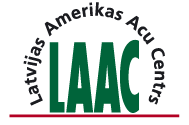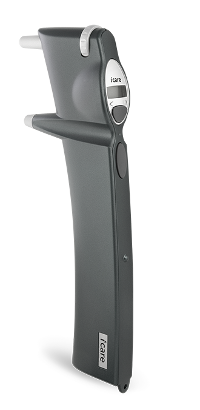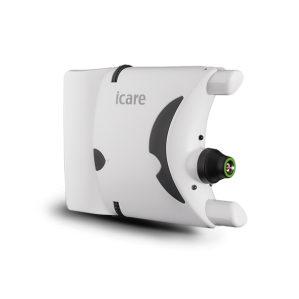Measuring internal eye pressure
Measuring internal eye pressure
At patient management, the Latvian American Eye Center uses tonometers of Finnish Company Icare Finland. These are specialized devices for measuring of intraocular (IOP) or internal eye pressure.
The tonometers used in clinic are devices of new generation applying unique so called “rebound” technology that makes IOP measuring quick, painless and accurate.
Why the control of internal eye pressure is needed?
Often, patients, questioned about eye pressure measuring, argue away that all is o.k. with blood pressure. These are two quite different measurements, the parameters of which do not necessarily mean features regarding one thing and the other. Regularly monitored blood pressure allows for avoiding different general diseases, infarct, blood stroke, but the measurements of internal eye pressure enable timely detection and elimination of vision problems that may have irreversible effects of loss of vision.
What is internal or intraocular (IOP) pressure?
The circulation of transparent fluid is constantly going in the eye. The liquid that washes and nourishes the avascular structures of the eye, as well as removes the metabolic end products is produced by the special gland – the ciliary body. In the tissues between the cornea and the sclera, there is a drainage area through which this fluid is discharged back into circulatory system. The pressure in the eye depends on the amount of produced fluid and removed fluid. It is too much or the fluid does not flow away, the pressure increases. The blockage of eye drainage system builds up fluid pressure that in turn may cause damage to optic nerve. If the optic nerve is damaged, blindness may occur. Excessive eye pressure also adversely affects other eye tissues. High pressure worsen metabolism in the eye. It pushes on the lens ligatures, weakens them, resulting in impaired vision, looking at different distances, the eye pupil becomes less mobile.
The cause of overproduction of aqueous humor may be hereditary, for example, if one of the blood relatives has or has glaucoma. The peculiarity of eye structure is sometimes the cause of high eye pressure when the angle of anterior chamber is narrowed or closed and the fluid cannot flow freely.
Overproduction of aqueous humor may be caused by high blood pressure, atherosclerotic changes in blood vessels, diabetes mellitus, thyroid and other endocrine diseases affecting blood circulation, as well as long term use of medications. Excessive pressure trends to result from injury when the aqueous humor is prevented from outflow, after inflammation or surgery. Sometimes high eye pressure is detected in patients with watering eyes. More often high eye pressure can be observed in patients, but the pressure in eye may be also low. In both cases, changes in eye pressure are equally unfavorable and may affect the quality of vision.
If the ciliary body produces too less fluid and the pressure is low, the eye nourishing is impaired. This may indicate serious damage to the structure of the eye, such as retinal breakdown and detachment of retina that can result in significant deterioration of vision or even blindness. The attention to measurements of eye internal pressure should also be paid after eye injuries and inflammations involving a fluid producing ciliary body. If it becomes less active and does not produce enough fluid, eye hypotonia may develop and the retina can be detached.
Sometimes eye pressure decreases after eye surgery. It means that wound in some place is not as properly closed that requires control of the doctor-surgeon who can spot and eliminate this problem.
Tonometers we use in the clinic and hire for patients for measuring at home:
Quick and easy IOP measuring without anesthesia and/or air. Icare TA01i tonometer is based on accurate measuring principle – a small probe is used to make momentary and gentle contact with the cornea. Process is quick and painless, often even without patient’s noticing, does not causes cornea reflex and, therefore, no local anesthesia is required. This device not only makes IOP measuring more pleasant for all patients, but also significantly improves IOP measuring in more complicated cases (for example, with pediatric patients, dementia patients, disabled persons).
The easy usage and dynamic patient flow ensured by Icare tonometer make this device an important tool not only for optometrists, but also for general practitioners, patients in home healthcare, veterinary clinics, pharmacies, etc.
Icare HOME model is designed for measuring of intraocular pressure at home.
Glaucoma patients need regular IOP monitoring, but it is impossible to visit an oculist, therefore, Icare has created this great product by the use of which the patients themselves can measure IOP in their daily routine and be always confident of their eye health. Icare HOME tonometer does not show figures, but automatically sends the measurement results to oculist, thus the doctor regularly obtains exact data that contribute to the progress of therapy.
For the convenience of patients and accurate measurements that are the basis for the choice of suitable medications, “Latvian American Eye Center” offers lease of tonometer ICARE Home. Measurement made at home are the most accurate as they can be taken immediately after awakening, before bedtime, before and after the use of medication or according to the times of the day recommended by the oculist.
Advantages of the use of the device at home:
- patient’s time is saved as it is not necessary to spend several days in the clinic to carry out regular eye-pressure tests for the choice of right medication – 3 tests are required during a day;
- possibility of obtaining the most accurate measurements – for example, to take morning measurement, the patient spends some timer on the way to the clinic. During this time the eye environment has already changed, while taking measurement immediately after awakening it shows the exact eye state under certain conditions;
- accurate monitoring of eye pressure can be done in the times of the day specified by the oculist and at your convenience – at home, on the way, at work because the device is small, easy portable.
More about renting equipment to be used at home here.






